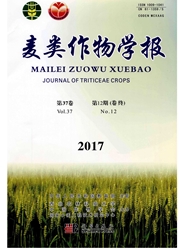

 中文摘要:
中文摘要:
为探索盐碱地燕麦的合理种植模式,在内蒙古包头市土默特右旗萨拉齐镇郊区重度盐碱地上以裸燕麦品种内农大莜1号为材料,对单作和混作种植模式下燕麦产量和生理指标进行了测定和分析。结果表明,混作燕麦的产量明显高于单作燕麦,且与苜蓿混作的产量最高,其经济产量为1028.4kg/ha,干草产量为9082.5kg/ha,分别是单作燕麦的2.09和1.69倍,即与苜蓿混作燕麦〉与披碱草混作燕麦〉单作燕麦。生理生化指标测定表明,质膜透性、丙二醛、脯氨酸、叶绿素含量随生育时期的变化基本呈先升后降趋势;与苜蓿混作的燕麦质膜透性在整个生育期最低,丙二醛含量变化相对平缓,叶绿素含量相对较高。可见与苜蓿混作有利于提高燕麦的耐盐碱能力。
 英文摘要:
英文摘要:
The effects of different planting patterns on oat (Neinongda You 1) yield and some physiological characters were studied under saline-alkaline stress condition in severe saline land of Sarachih town Baotou city suburb of Inner Mongolia. The results showed that the oat yield in mixed-cropping was higher than monoculture,and yield in mixed-cropping of oat and alfalfa was the maximum. ,the economical output was 1 028.4 kg/ha,hay yield was 9 082.5 kg/ha,and they were 2.09 times and 1.69 times that of sole oat cropping, respectively. Physiological index determination showed that the relative permeability of plasmalemma,MDA content,proline content and chlorophyll content increased at first and then gradually decline with the development of oat, the relative permeability of plasmalemma of the oat which mixed with alfalfa was the lowest during different growth stages, the change of the MDA content was relatively smooth,and it was lower and the content of chlorophyll was higher than other treatments at late growth stage. The oat mixed with alfalfa can increase saline-alkaline resistance of oat.
 同期刊论文项目
同期刊论文项目
 同项目期刊论文
同项目期刊论文
 期刊信息
期刊信息
